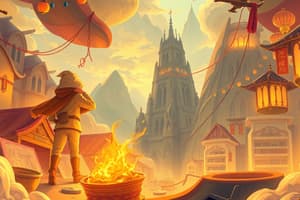Podcast
Questions and Answers
What is the primary focus of economics?
What is the primary focus of economics?
- Study of individual behaviors in isolation.
- Examination of how resources are allocated. (correct)
- Research on consumer psychology.
- Analysis of government policies only.
Which concept describes the benefit lost when choosing one alternative over another?
Which concept describes the benefit lost when choosing one alternative over another?
- Market Equilibrium
- Scarcity
- Opportunity Cost (correct)
- Elasticity
What determines market prices according to the concept of supply and demand?
What determines market prices according to the concept of supply and demand?
- The amount of money in circulation.
- Consumer preferences and producer regulations.
- Government policies on production.
- The interaction between supply and demand. (correct)
What does market equilibrium represent?
What does market equilibrium represent?
What does elasticity measure in economic terms?
What does elasticity measure in economic terms?
Which economic system typically emphasizes private ownership and a market-driven economy?
Which economic system typically emphasizes private ownership and a market-driven economy?
What is the primary difference between macroeconomics and microeconomics?
What is the primary difference between macroeconomics and microeconomics?
What does fiscal policy primarily include?
What does fiscal policy primarily include?
Flashcards
What is Economics?
What is Economics?
The study of how individuals, businesses, and governments allocate scarce resources to satisfy unlimited wants.
What is Opportunity Cost?
What is Opportunity Cost?
The value of the next best alternative forgone when making a choice.
What is Supply?
What is Supply?
The quantity of a good that producers are willing to sell at various prices.
What is Demand?
What is Demand?
Signup and view all the flashcards
What is Market Equilibrium?
What is Market Equilibrium?
Signup and view all the flashcards
What is Macroeconomics?
What is Macroeconomics?
Signup and view all the flashcards
What is Microeconomics?
What is Microeconomics?
Signup and view all the flashcards
What is Fiscal Policy?
What is Fiscal Policy?
Signup and view all the flashcards
Study Notes
Definition of Economics
- Study of how individuals, businesses, and governments allocate resources.
- Examines production, distribution, and consumption of goods and services.
Key Concepts
-
Scarcity
- Limited resources vs. unlimited wants.
- Forces choices and trade-offs.
-
Opportunity Cost
- The value of the next best alternative forgone when making a choice.
-
Supply and Demand
- Supply: Quantity of a good that producers are willing to sell at various prices.
- Demand: Quantity of a good that consumers are willing to purchase at various prices.
- Interaction determines market prices.
-
Market Equilibrium
- Point where supply equals demand.
- Results in stable prices.
-
Elasticity
- Measures responsiveness of quantity demanded or supplied to changes in price.
- Price Elasticity of Demand: Sensitive vs. insensitive demand changes.
-
Economic Systems
- Capitalism: Private ownership, market-driven.
- Socialism: Collective ownership, planned economy.
- Mixed Economy: Combination of capitalism and socialism.
Macroeconomics vs. Microeconomics
- Macroeconomics: Study of the economy as a whole (e.g., GDP, inflation, unemployment).
- Microeconomics: Study of individual consumers and businesses.
Key Indicators
- Gross Domestic Product (GDP): Total value of goods and services produced.
- Inflation Rate: Measure of price increase over time.
- Unemployment Rate: Percentage of the labor force that is jobless.
Fiscal and Monetary Policy
- Fiscal Policy: Government spending and taxation decisions to influence the economy.
- Monetary Policy: Central bank actions to control money supply and interest rates.
Economic Growth
- Increase in the production of goods and services over time.
- Indicators include rising GDP, improved standards of living.
Trade and Globalization
- International exchange of goods and services.
- Benefits include access to larger markets, diverse products.
- Risks include economic dependency and job displacement.
Economic Development
- Focus on improving economic well-being and quality of life.
- Involves infrastructure, education, healthcare, and poverty reduction efforts.
Definition of Economics
- Economics involves understanding how resources are allocated by individuals, businesses, and governments.
- Focuses on the production, distribution, and consumption of goods and services.
Key Concepts
- Scarcity: Addresses the conflict between limited resources and unlimited wants, necessitating choices and trade-offs.
- Opportunity Cost: Represents the value of the next best alternative that is given up when a choice is made.
- Supply and Demand:
- Supply: Reflects the amount of a good that producers are prepared to sell at different price points.
- Demand: Indicates how much of a good consumers are willing to buy at varying prices.
- Interaction of supply and demand influences market pricing.
- Market Equilibrium: Occurs where the quantity supplied equals the quantity demanded, leading to stable prices.
- Elasticity: Assesses how responsive the quantity demanded or supplied is to price changes.
- Price Elasticity of Demand: Differentiates between highly sensitive (elastic) and less sensitive (inelastic) demand responses to price adjustments.
- Economic Systems:
- Capitalism: Characterized by private ownership and market-driven processes.
- Socialism: Based on collective ownership with a planned economy structure.
- Mixed Economy: Integrates elements of both capitalism and socialism.
Macroeconomics vs. Microeconomics
- Macroeconomics: Examines the entire economy, focusing on indicators such as GDP, inflation, and unemployment.
- Microeconomics: Analyzes individual consumer and business behaviors.
Key Indicators
- Gross Domestic Product (GDP): Total monetary value of all goods and services produced within a country's borders.
- Inflation Rate: Measures the rate at which the general price levels of goods and services rise over time.
- Unemployment Rate: Percentage of the labor force that is actively seeking work but unable to find employment.
Fiscal and Monetary Policy
- Fiscal Policy: Involves government decisions regarding spending and taxation to influence economic activity.
- Monetary Policy: Actions taken by a central bank to regulate money supply and manage interest rates in the economy.
Economic Growth
- Represents an increase in the production of goods and services over an extended period.
- Indicators of economic growth include rising GDP and enhanced standards of living.
Trade and Globalization
- Involves the international exchange of goods and services, allowing for larger market access and a variety of products.
- Benefits include greater market opportunities, while risks encompass economic dependency and potential job losses.
Economic Development
- Aiming to improve economic stability and quality of life, focusing on infrastructure, education, healthcare, and efforts to alleviate poverty.
Studying That Suits You
Use AI to generate personalized quizzes and flashcards to suit your learning preferences.




